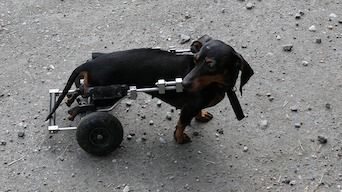Fetch 2018: Disk Disease Treatment Can Include Steroids
When used appropriately, steroids can play an integral role in the management of intervertebral disk disease.
“I am a veterinarian, and I love steroids,” confessed Simon Platt, BVM&S, FRCVS, DACVIM, DECVN, at the opening of his lecture on management of intervertebral disk disease (IVDD) at the Fetch 2018 conference in San Diego. Dr. Platt acknowledged that the use of steroids in the medical management of IVDD has been controversial. However, he suggested that steroids can be a powerful tool in the medical management of IVDD when used appropriately.

Two treatment options exist for patients with IVDD: conservative medical management and surgery. Both treatments have their place, and what is best for each patient depends on several factors, the most important of which is the patient’s neurologic status.
IVDD is divided into 5 grades based on the results of neurologic examination:
- Grade 1: Back pain without motor impairment
- Grade 2: Ambulatory paraparesis
- Grade 3: Non-ambulatory paraparesis
- Grade 4: Paraplegia with pain perception
- Grade 5: Paraplegia without deep pain perception
These grades can be used to determine patient prognosis with both medical and surgical therapy. It is important for clients to understand that successful treatment does not always mean a return to normal function. In cases of IVDD, successful treatment results in a patient that is pain-free, ambulates without assistance, and maintains urinary and fecal continence.
For patients presenting with grade 1 or 2 IVDD, medical and surgical therapy are equally effective with a 90% success rate. The difference in prognosis between these 2 therapies begins to be seen at grade 3. At this grade, surgical management remains 90% effective, but medical management is still 70% successful.
Once a patient is paralyzed, surgical management is by far the better treatment option, according to the presentation. Patients with grade 4 disease have only a 50% chance of recovery with medical management, and patients with grade 5 disease have less than a 5% chance of recovery with medical management.
Conservative Management Protocols
Rest is an essential component of therapy, Dr. Platt noted. Cage rest should be continued for 4 to 6 weeks in all cases to give the disk time to heal. In addition to rest, pain control is essential for successful outcomes with medical therapy. Because the pathophysiology of IVDD is complex, he encouraged veterinarians to use multimodal pain control.
While NSAIDs are often prescribed, Dr. Platt prefers anti-inflammatory doses of steroids. A short course of prednisone at 0.5 to 1 mg/kg/day is excellent at reducing inflammation and achieving analgesia in the spinal cord. The low dose and short course are the keys to successful use of steroids in these cases. Inflammation and pain should be resolved within several days of spinal injury. In patients with refractory pain or worsening disease in the face of medical management, surgical therapy should be strongly considered.
Other pharmaceutical options for pain control include opioids, gabapentin, and muscle relaxants such as diazepam or methocarbamol.
Take-Home Message
Medical management of IVDD is highly successful in patients who present with motor function. In these patients, a combination of rest and pain control are essential to a successful outcome. Due to their anti-inflammatory properties, the use of short-term, low-dose steroids can improve patient comfort and should be considered.
Dr. Boatright, a 2013 graduate of the University of Pennsylvania, is an associate veterinarian in western Pennsylvania. She is actively involved in her state and local veterinary medical associations and is a former national officer of the Veterinary Business Management Association.